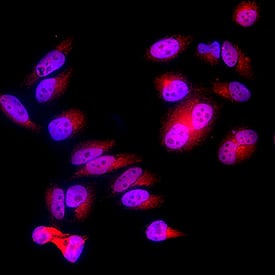



 下载产品说明书
下载产品说明书 下载SDS
下载SDS 用小程序,查商品更便捷
用小程序,查商品更便捷



 收藏
收藏
 对比
对比 咨询
咨询Immunohistochemistry(5-15 µg/mL)
Immunohistochemistry(5-15 µg/mL)




Val332-Lys558
Accession # Q06219

Scientific Data
 View Larger
View LargerNurr1/NGFI‑B beta /NR4A2 in HeLa Human Cell Line. Nurr1/NGFI‑B beta /NR4A2 was detected in immersion fixed HeLa human cervical epithelial carcinoma cell line using Goat Anti-Human/Mouse Nurr1/NGFI‑B beta /NR4A2 Antigen Affinity-purified Polyclonal Antibody (Catalog # AF2156) at 10 µg/mL for 3 hours at room temperature. Cells were stained using the NorthernLights™ 557-conjugated Anti-Goat IgG Secondary Antibody (red; NL001) and counterstained with DAPI (blue). Specific staining was localized to cytoplasm and nuclei. Staining was performed using our protocol for Fluorescent ICC Staining of Non-adherent Cells.
 View Larger
View LargerNurr1/NGFI‑B beta /NR4A2 in Mouse Brain (Hippocampus). Nurr1/NGFI‑B beta /NR4A2 was detected in immersion fixed paraffin-embedded sections of mouse brain (hippocampus) using Goat Anti-Human/Mouse Nurr1/NGFI‑B beta /NR4A2 Antigen Affinity-purified Polyclonal Antibody (Catalog # AF2156) at 15 µg/mL for 1 hour at room temperature followed by incubation with the Anti-Goat IgG VisUCyte™ HRP Polymer Antibody (VC004). Before incubation with the primary antibody, tissue was subjected to heat-induced epitope retrieval using Antigen Retrieval Reagent-Basic (CTS013). Tissue was stained using DAB (brown) and counterstained with hematoxylin (blue). Specific staining was localized to cytoplasm in neurons. Staining was performed using our protocol for IHC Staining with VisUCyte HRP Polymer Detection Reagents.
Human/Mouse Nurr1/NGFI-B beta /NR4A2 Antibody Summary
Val332-Lys558
Accession # Q06219
Applications
Please Note: Optimal dilutions should be determined by each laboratory for each application. General Protocols are available in the Technical Information section on our website.
Immunohistochemistry(5-15 µg/mL)


Background: Nurr1/NGFI-B beta/NR4A2
Nurr1 belongs to the nerve growth factor-induced clone B subfamily of nuclear receptor superfamily and is designated NR4A2 in the Unified Nomenclature System for NRs. Nurr1 can function as a ligand-independent transcription factor. Nurr1 also heterodimerizes with retinoid X receptors (RXRs) to function as ligand-regulated transcription factor. Nurr1 is important for specification of dopaminergic neurons that degenerate in Parkinson’s disease. Human and mouse Nurr1 share 99% amino acid sequence homology.


Preparation and Storage
- 12 months from date of receipt, -20 to -70 °C as supplied.
- 1 month, 2 to 8 °C under sterile conditions after reconstitution.
- 6 months, -20 to -70 °C under sterile conditions after reconstitution.






 危险品化学品经营许可证(不带存储) 许可证编号:沪(杨)应急管危经许[2022]202944(QY)
危险品化学品经营许可证(不带存储) 许可证编号:沪(杨)应急管危经许[2022]202944(QY)  营业执照(三证合一)
营业执照(三证合一)